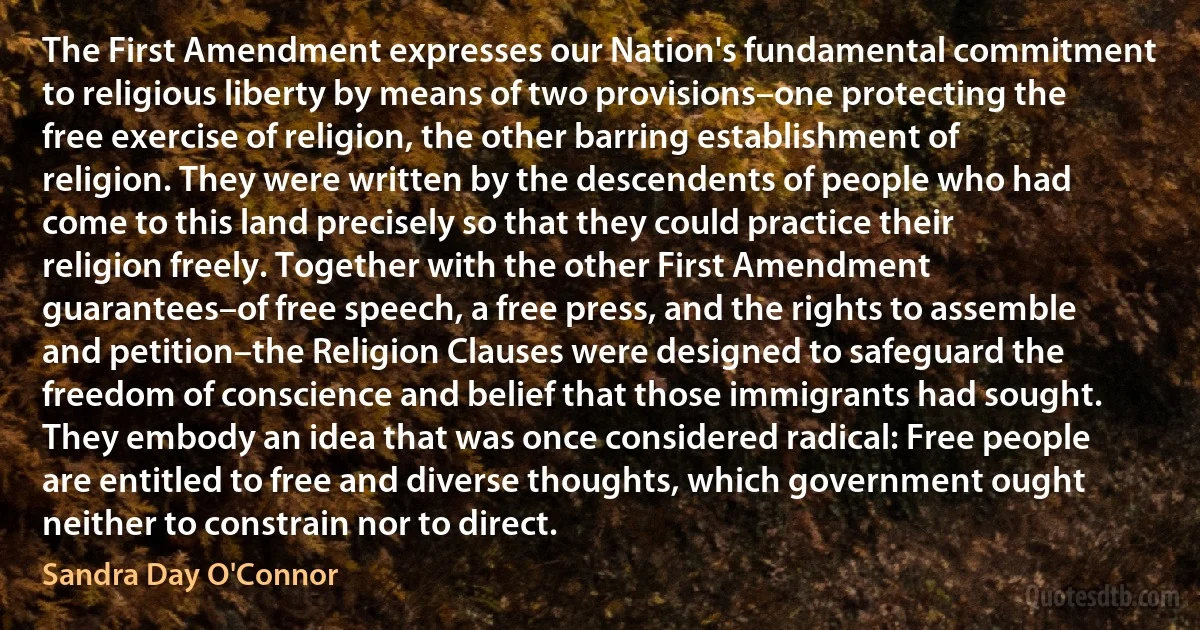
The First Amendment expresses our Nation's fundamental commitment to religious liberty by means of two provisions–one protecting the free exercise of religion, the other barring establishment of religion. They were written by the descendents of people who had come to this land precisely so that they could practice their religion freely. Together with the other First Amendment guarantees–of free speech, a free press, and the rights to assemble and petition–the Religion Clauses were designed to safeguard the freedom of conscience and belief that those immigrants had sought. They embody an idea that was once considered radical: Free people are entitled to free and diverse thoughts, which government ought neither to constrain nor to direct.
Sandra Day O'ConnorRelated topics
barring conscience establishment free freedom fundamental government idea land liberty nor once ought people petition practice religion seek speech write meansRelated quotes
This attempt to usurp the government by subverting the Constitution of the United States was the policy of the greatest leader the system of slavery has ever had in this country - that pagan of our politics, Mr. Calhoun. While other statesmen merely saw, he foresaw. His mind, of large forecast and comprehensive grasp, perceived that the logic of history, of civilization, of our national idea, of the universal conscience, was against slavery. But he had seen the conscience of the country, roused for a moment in the Missouri debate, drop asleep again. And with the audacity of genius he resolved to stun the country into acquiescence by claiming that slavery was the fundamental law of the land.

George William Curtis
In every nation thou beholdest unnumbered spiritual leaders who are bereft of true discernment, and among every people thou dost encounter myriads of adherents who are devoid of the same characteristic. Ponder for a while in thy heart, have pity on thyself and turn not aside thine attention from proofs and evidences. However, seek not proofs and evidences after thine idle fancy; but rather base thy proofs upon what God hath appointed. Moreover, know thou that neither being a man of learning nor being a follower is in itself a source of glory. If thou art a man of learning, thy knowledge becometh an honour, and if thou art a follower, thine adherence unto leadership becometh an honour, only when these conform to the good-pleasure of God.

Báb
The creationist is a sham religious person who, curiously, has no true sense of religion. In the language of religion, it is the facts we observe in the world around us that must be seen to constitute the words of God. Documents, whether the Bible, Qur'an or those writings that held such force for Velikovsky, are only the words of men. To prefer the words of men to those of God is what one can mean by blasphemy. This, we think, is the instinctive point of view of most scientists who, curiously again, have a deeper understanding of the real nature of religion than have the many who delude themselves into a frenzied belief in the words, often the meaningless words, of men. Indeed, the lesser the meaning, the greater the frenzy, in something like inverse proportion.

Fred Hoyle
It is also the becoming-space of the spoken chain - which has been called temporal or linear; a becoming-space which makes possible both writing and every correspondence between speech and writing, every passage from one to the other.
The activity or productivity connoted by the a of différance refers to the generative movement in the play of differences. The latter are neither fallen from the sky nor inscribed once and for all in a closed system, a static structure that a synchronic and taxonomic operation could exhaust. Differences are the effects of transformations, and from this vantage the theme of différance is incompatible with the static, synchronic, taxonomic, ahistoric motifs in the concept of structure.

Jacques Derrida
I'm aware of the made up declarations about me that have recently begun to appear on the Internet and in emails as "Chuck Norris facts." I've seen some of them. Some are funny. Some are pretty far out. Being more a student of the Wild West than the wild world of the Internet, I'm not quite sure what to make of it. It's quite surprising. I do know that boys will be boys, and I neither take offense nor take these things too seriously. Who knows, maybe these made up one-liners will prompt young people to seek out the real facts as found in my recent autobiographical book, "Against All Odds?" They may even be interested enough to check out my novels set in the Old West, "The Justice Riders," released this month. I'm very proud of these literary efforts.

Chuck Norris
